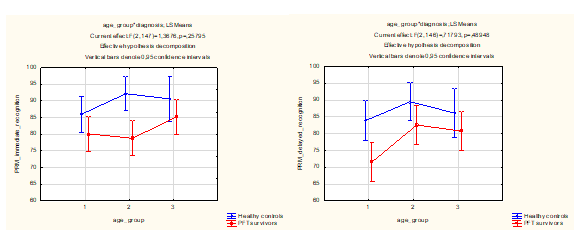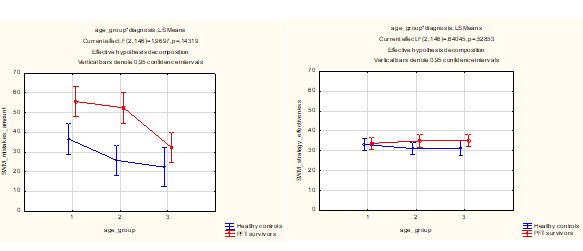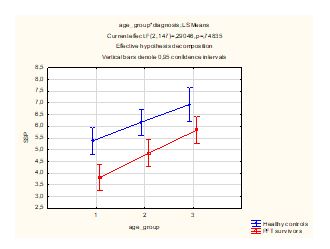Abstract
For the moment, specialists do not agree on the issue of executive functions structure. However, there is a lot of data proving their connection with intellect quotient, academic achievements and great influence on everyday life. For understating what «executive functions» are we need to know their evolution during normal and pathological development. In this work, we have shown the development of executive functions from 6 to 17 years. We used three tests PRM, SWM and SSP from Cambridge Neuropsychological Test Automated Battery for assessing short-term and working memory in pediatric cancer survivors and healthy controls. Two groups participated in the study: patients who survived posterior fossa tumors, and healthy controls. Both groups were also divided into three age subgroups for the analysis of age dynamics in cognitive functions development. The findings show a significant difference between the groups in both domains. The results reveal that the volume of short-term and working memory increases with adulating, whereas the amount of mistakes decreases due to the improvement of control functioning. Children after cancer demonstrate abnormal development as their results are worse than those of peers. Hereby executive functions pass their stages of development, and this development can be easily impaired by illness or injury.
Keywords: Cognitive functionsexecutive functionspediatric cancerdevelopmentworking memoryshort-term memory
Introduction
Research on human intellect has led to a new theoretical construct in cognitive psychology which is known as executive functions. Executive functions are often represented as consolidation of cognitive processes, which start to function when ordinary behavior is not enough to reach the aim and the situation demands supplementary control (Vilenckaya, 2016; Nikolaeva, 2017). The studies show that proper behavior in new or complex environment is a result of retrieving relevant information, its containing, changing, and shifting between several tasks, as well as inhibition of irrelevant information (Brandenburg, & Putz, 2006).
The investigations in the field of developmental psychology demonstrate that executive functions develop and become more and more complex as a child grows up (Anderson, et al., 2001). There is evidence that executive functions are associated with intellect (Zakharov, 2016) and academic achievements (Nesbitt, 2015). Given the essential role of them in individual’s life, they are also quite fragile. Hence, different diseases, such as cancer, can cause the impairment of cognitive functioning (Benzing, 2018; Nesbitt, 2015). The pathological processes lead to the retarded functioning and even destruction of executive functions.
Tumors arising in the brain’s posterior fossa are the most common type of pediatric brain tumors (Hanzlik, 2015). Methods of treatment, such as surgical rejection, radiotherapy and chemotherapy, have provided substantial increase in patients’ survival rates. Nevertheless, the disease itself as well as late effects of therapy can impair cognitive functions. Frequently observed deficits in posterior fossa tumor (PFT) survivors include executive functions decrease due to the cerebellum pathology involvement (Wolfe, 2012).
Problem Statement
In the field of education we have two essential questions: “How do children study?” and “How can we help?” Executive functions represent a predictor of success in school, but we still don’t know enough about state of executive functions in healthy schoolchildren.
For understanding what “normal state” of executive functions is, we need to find out what the abnormal one is. In our research, we estimated short-term and working memory in groups of children who had survived brain tumours and healthy schoolchildren.
Research Questions
-
Do executive functions change during school, or do children have formed EF by the age of 6 years?
-
Can a disease affect executive functions in schoolchildren?
-
In what way does a disease affect executive functions in schoolchildren?
Purpose of the Study
The aim of the study was to determine the state of short-term and working memory in different age groups of pediatric brain tumor survivors and healthy controls.
Research Methods
Cambridge Neuropsychological Test Automated Battery (CANTAB) is research software providing sensitive digital measures of cognitive functioning. We used 3 subtests: Pattern Recognition Memory (PRM) designed for the assessment of visual pattern recognition memory in a 2-choice forced discrimination paradigm; Spatial Working Memory (SWM) which requires retention and manipulation of visuospatial information and provides a measure of strategy as well as working memory errors; and Spatial Span (SSP), which estimates visuospatial working memory capacity (Cambridge Cognition, 2018, http://www.cambridgecognition.com).
Participants. The following groups participated in the trial: 82 PFT survivors (34 females, 48 males, mean age was 11,38±3,32) and 69 healthy controls (32 females, 37 males, mean age was 11,08±2,2,52). For the analysis of age dynamics in cognitive functions state, both groups were divided into three age subgroups: 6-9 years old, 10-13 years old, and 14-17 years old (Table
Findings
The results reveal a significant difference between pediatric cancer survivors and healthy controls in the domains of short-term and working memory (Table
The findings also show age differences in the domain of short-term and working memory in the subgroups. It means that the volume of short-term and working memory increases with adulting, whereas the amount of mistakes decreases due to improving control functioning. The same dynamics can be observed both in a group of patients and a group of healthy controls: the youngest subgroups of elementary school students demonstrates the worst results, the secondary school children have better ones, and the high school children have the best scores (Fig.



Therefore, we can observe age differences in both groups. However, PFT survivors show worse results, so we can assume the influence of the disease on cognitive functions state. Moreover, high school children who survived brain tumors cannot reach the appropriate level of memory function even at the end of school period. Hence, this diagnosis causes abnormal development of cognitive functions, and the consequences of its influence can be permanent and even irreversible. The same results have been received in other investigations (Riva, & Giorgi, 2000).
Conclusion
The received data allows us to conclude that there is a significant difference between the group of PFT survivors and healthy controls in the domains of short-term and working memory: the patients show worse results. The evidence of age dynamics in both groups has also been found. The scores of elements in memory, an amount of mistakes and effectiveness of strategy depend on age: the older children are, the better results they demonstrate. The group of patients still shows the positive dynamics of cognitive functions with aging, but due to the disease they cannot reach age-appropriate normal values.
References
- Anderson, V. A., Anderson, P., Northam, E., Jacobs, R., & Catroppa, C. (2001). Development of executive functions through late childhood and adolescence in an Australian sample. Developmental neuropsychology, 20(1), 385-406.
- Benzing, V., Eggenberger, N., Spitzhüttl, J., Siegwart, V., Pastore-Wapp, M., Kiefer, C., ... & Conzelmann, A. (2018). The Brainfit study: efficacy of cognitive training and exergaming in pediatric cancer survivors–a randomized controlled trial. BMC cancer, 18(1), 18.
- Brandenburg, K., & Putz, H. (2006). Diamond. Crystal Impact GbR, Bonn, Germany.
- Cambridge Cognition (2018) Retrieved from http://www.cambridgecognition.com
- Hanzlik, E., Woodrome, S. E., Abdel-Baki, M., Geller, T. J., & Elbabaa, S. K. (2015). A systematic review of neuropsychological outcomes following posterior fossa tumor surgery in children. Child's Nervous System, 31(10), 1869-1875.
- Levisohn, L., Cronin-Golomb, A., & Schmahmann, J. D. (2000). Neuropsychological consequences of cerebellar tumour resection in children: cerebellar cognitive affective syndrome in a paediatric population. Brain, 123(5), 1041-1050.
- Nesbitt, K. T., Farran, D. C., & Fuhs, M. W. (2015). Executive function skills and academic achievement gains in prekindergarten: Contributions of learning-related behaviors. Developmental Psychology, 51(7), 865.
- Nesbitt, K. T., Farran, D. C., &Fuhs, M. W. (2015). Executive function skills and academic achievement gains in prekindergarten: Contributions of learning-related behaviors. Developmental Psychology, 51(7), 865.
- Nikolaeva E.I. & Vergunov E.G. (2017). CHtotakoe «executive functions» iihrazvitie v ontogeneze. Teoreticheskaya i ehksperimental'naya psihologiya, 10(2).
- Riva, D., & Giorgi, C. (2000). The cerebellum contributes to higher functions during development: evidence from a series of children surgically treated for posterior fossa tumours. Brain, 123(5), 1051-1061.
- Robinson, K. E., Kuttesch, J. F., Champion, J. E., Andreotti, C. F., Hipp, D. W., Bettis, A., ... &Compas, B. E. (2010). A quantitative meta-analysis of neurocognitive sequelae in survivors of pediatric brain tumors. Pediatric blood & cancer, 55(3), 525-531.
- Vilenskaya G.A. (2016). Ispolnitel'nyefunkciiprirodaiihrazvitie. Psihologicheskij zhurnal, 37(4), 21-31.
- Wolfe, K. R., Madan-Swain, A., & Kana, R. K. (2012). Executive dysfunction in pediatric posterior fossa tumor survivors: A systematic literature review of neurocognitive deficits and interventions. Developmental neuropsychology, 37(2), 153-175.
- Wolfe, K. R., Walsh, K. S., Reynolds, N. C., Mitchell, F., Reddy, A. T., Paltin, I., & Madan-Swain, A. (2013). Executive functions and social skills in survivors of pediatric brain tumor. Child Neuropsychology, 19(4), 370-384.
- Zakharov, I. M., Voronin, I. A., Ismatullina, V. I. & Malykh, S. B. (2016). The relationship between visual recognition memory and intelligence. Procedia-Social and Behavioral Sciences, 233, 313-317.
Copyright information

This work is licensed under a Creative Commons Attribution-NonCommercial-NoDerivatives 4.0 International License.
About this article
Publication Date
23 November 2018
Article Doi
eBook ISBN
978-1-80296-048-8
Publisher
Future Academy
Volume
49
Print ISBN (optional)
-
Edition Number
1st Edition
Pages
1-840
Subjects
Educational psychology, child psychology, developmental psychology, cognitive psychology
Cite this article as:
Ryabova, A., Dreneva, A., Somov, D., Kasatkin, V., & Malykh, S. (2018). Cognitive Functions State In Pediatric Cancer Survivors And Healthy Controls. In S. Malykh, & E. Nikulchev (Eds.), Psychology and Education - ICPE 2018, vol 49. European Proceedings of Social and Behavioural Sciences (pp. 582-587). Future Academy. https://doi.org/10.15405/epsbs.2018.11.02.65

